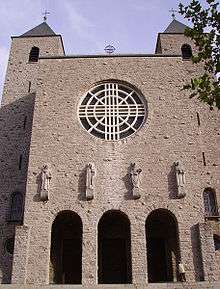Münsterschwarzach Abbey

Münsterschwarzach Abbey (Abtei Münsterschwarzach, formerly often known as Kloster Schwarzach or Schwarzach Abbey), is a Benedictine monastery in Germany. It is located at the confluence of the rivers Schwarzach and Main in Bavaria.
Carolingian nunnery
The abbey, dedicated to the Holy Saviour, the Virgin Mary and Saint Felicity, was founded before 788 as a nunnery. It was a private foundation of the Carolingian ruling house: the abbesses were daughters of the imperial family, for example Theodrada (d. 853), a daughter of Charlemagne. After the death of the last Carolingian abbess, Bertha, in 877, the nuns left the abbey and it was taken over by Benedictines from "Megingaudshausen".
First Benedictine monastery
Münsterschwarzach became a centre of monastic reform during the 12th century, when Bishop Adalbero of Würzburg, who was in close contact with the reform movements of Cluny, Gorze and Hirsau, appointed Egbert of Gorze as abbot. Egbert not only reformed and renewed the spiritual life of Münsterschwarzach but then, through the spread of the subsequent Münsterschwarzach Reforms, exerted an influence far beyond it, from Harsefeld Archabbey near Stade in the north to Melk and Lambach in the south.
In the 18th century a Baroque basilica was commissioned from Balthasar Neumann, with frescoes in the cupolas by Holzer; it was dedicated in 1743 by Bishop Friedrich Karl von Schönborn.
In 1803 the abbey was dissolved in the course of the secularisation of Bavaria. The monastic buildings were auctioned off. In 1805 the abbey church was sold and deconsecrated. In 1810 the buildings were struck by lightning and severely damaged by the subsequent fire, and between 1821 and 1827 the remains of the church were entirely demolished, and those of the monastic buildings largely demolished.
Second Benedictine monastery
In 1913 the remains of the old abbey were re-acquired by the Missionary Benedictines, along with the necessary land to support it. The first abbot after the restoration was Dom Placidus Vogel (1914-1937). He was followed by Dom Burkhard Utz (1937-1959) and Dom Bonifaz Vogel (1959-1982), a nephew of Abbot Placidus. The monumental abbey church with its four towers was built between 1935 and 1938, when it was dedicated. The architect was Albert Bosslet.
Between 1941 and 1945 the abbey was confiscated by the National Socialists and used as a military hospital. Although the monastic community had been expelled, some monks were able to remain as workers in the hospital. It reopened after the war. The present abbot is Michael Reepen OSB.
The abbey has two dependent monasteries. Christ the King Priory in Schuyler, Nebraska (USA) was established in 1935; Damme Priory (Germany) in 1962.
References
- Muth, Erwin, 2004. P. Burkard Bausch OSB (1656-1721/1723), Benediktinermönch und Chronist, in: Fränkische Lebensbilder (Veröffentlichungen der Gesellschaft für Fränkische Geschichte) 20, pp. 119 - 135 (account of the chronicler of Münsterschwarzach)
External links
| Wikimedia Commons has media related to Münsterschwarzach. |
- (German) Münsterschwarzach Abbey website
- (English) Christ the King Priory Schuyler website
- (German) Haus Benedikt
- (German) Klöster in Bayern: Münsterschwarzach
Coordinates: 49°48′19″N 10°13′54″E / 49.80528°N 10.23167°E